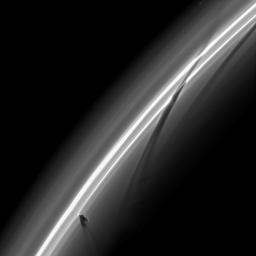
|
Busy Moon
- Click the image above for a larger view
- Full-Res JPEG (1018 x 1018) (39.1 kB)
- Full-Res TIFF (1018 x 1018) (1.0 MB)
Caption:
Half an hour after Prometheus tore into this region of Saturn's F ring, the Cassini spacecraft snapped this image just as the moon was creating a new streamer in the ring.The dark pattern shaped like an upside down check mark in the lower left of the image is Prometheus and its shadow. The potato shaped moon can just be seen coming back out of the ring.
The moon's handiwork also is apparent in two previous streamer-channel formations on the right of the image. The darkest streamer-channel stretching from the top right to the center of the image shows Prometheus' previous apoapse passage about 15 hours earlier. A fainter, even earlier channel extends to the edge of the image.
Prometheus (86 kilometers, or 53 miles across) dips into the inner edge of the F ring when it reaches apoapse, the moon's farthest orbital point from Saturn. At apoapse, the moon's gravity pulls particles of the ring outward into a streamer.
As Prometheus moves onward toward periapse—its orbit's closest point to the planet—the streamer gets longer. Then, as Prometheus moves back toward apoapse, the streamer breaks apart which results in a dark channel.
This streamer-channel cycle repeats once every orbit with the streamer-channel features being streamers during Prometheus periapse and channels during Prometheus apoapse.
The F ring is overexposed in this image which has been brightened to reveal the moon.
This view looks toward the unilluminated side of the rings from about 18 degrees above the ringplane. The image was taken in visible light with the Cassini spacecraft narrow-angle camera on Jan. 14, 2009. The view was obtained at a distance of approximately 555,000 kilometers (345,000 miles) from Saturn and at a Sun-Saturn-spacecraft, or phase, angle of 145 degrees. Image scale is 3 kilometers (2 miles) per pixel.
Background Info:
The Cassini-Huygens mission is a cooperative project of NASA, the European Space Agency and the Italian Space Agency. The Jet Propulsion Laboratory, a division of the California Institute of Technology in Pasadena, manages the mission for NASA's Science Mission Directorate, Washington, D.C. The Cassini orbiter and its two onboard cameras were designed, developed and assembled at JPL. The imaging operations center is based at the Space Science Institute in Boulder, Colo.
For more information about the Cassini-Huygens mission visit http://saturn.jpl.nasa.gov/ . The Cassini imaging team homepage is at http://ciclops.org .
Cataloging Keywords:
| Name | Value | Additional Values |
|---|---|---|
| Target | Saturn Rings | F Ring, Prometheus, Saturn |
| System | Saturn | |
| Target Type | Ring | Planet, Satellite |
| Mission | Cassini-Huygens | |
| Instrument Host | Cassini Orbiter | |
| Host Type | Orbiter | |
| Instrument | Imaging Science Subsystem (ISS) | |
| Detector | Narrow Angle Camera | |
| Extra Keywords | Grayscale, Shadow, Visual | |
| Acquisition Date | ||
| Release Date | 2009-03-06 | |
| Date in Caption | 2009-01-14 | |
| Image Credit | NASA/JPL/Space Science Institute | |
| Source | photojournal.jpl.nasa.gov/catalog/PIA10593 | |
| Identifier | PIA10593 | |
